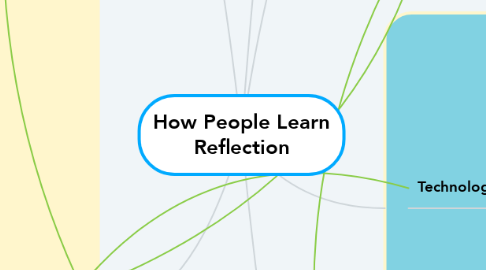How People Learn Reflection
by Michaela Spence


1. Learners
1.1. Motivation
1.2. Engage in their own learning
1.3. Make connections to the real world
1.4. Sharing thoughts and knowledge about topic
1.5. Learn from peers through discussion
2. Classroom Practices
2.1. Formative assessments
2.2. T provides feedback to guide student learning
2.3. 5E/7E Model
2.4. Metacognitive Circles
2.5. Be adaptive in the teaching process; engage learners where they are
2.6. Outside speakers/experts on topic
2.7. Inquiry
2.8. Incorporate Technology (simulations, videos, current events, etc.)
2.9. Knowledge Retention
2.9.1. 1. Retrieval Practice
2.9.2. 2. Spaced Practice
2.9.3. 3. Interleaved and Varied Practice
2.9.4. 4. Summarizing and Drawing
2.9.5. 5. Ss Teaching/Explaining to peers
3. National Boards
3.1. T committed to S learning
3.2. T knows subject and how to teach subject
3.3. T responsible for managing and monitoring learning
3.4. T think systimatically
3.5. T are member of learning community
4. Teachers
4.1. Instill Metacognitive Skills
4.2. Discover student motivations
4.3. Connect learning to real world application
4.4. Know content knowledge (Expert)
4.5. Align standards and assessment with activities/lessons
4.6. Memorization vs. Understanding
4.7. Provide Feedback
4.8. Model Learning=GUIDE of lesson!
4.9. Expose Student Misconceptions
5. Technology
5.1. Collaborative vs. Cooperative Learning
5.2. Consumers of technology vs. Producers
5.3. Uses of technology
5.3.1. Games
5.3.2. Simulations
5.3.3. Web-based Labs
5.3.4. Design (3-D, PPT, Canvas, etc.)
5.4. Should have an authentic use!!
5.5. ISTE Standards
5.6. ALCOS Digital Literacy and Computer Science Standards
6. Empowering Students the Book
6.1. Students take ownership of learning
6.2. L.A.U.N.C.H.
6.2.1. L: Look, Listen, and Learn
6.2.2. A: Ask tons of questions
6.2.3. U: Understand the process or problem
6.2.4. N: Navigate Ideas
6.2.5. C: Create Prototype
6.2.6. H: Highlight what works and fix what doesn't
6.3. Find what works for each student--> Ice Cream Model
6.3.1. Baskin Robins
6.3.2. Fro-Yo
6.3.3. Coldstone Cremery
6.4. Students can be both consumers and producers
6.5. Understand the Ss mindset
6.5.1. Motivation
6.5.2. Prior Knowledge
6.5.3. Interest
6.6. Failing=Temporary
6.6.1. Failure=Permanent
